Create Single Page TIFF Files
There are many reasons why you would need to create single page TIFF files. You might have a report of invoices for the month where each invoice is on a separate page. When creating TIFF images from this report, you want to create a single file for each page, or invoice, in the report.
Both TIFF Image Printer and Raster Image Printer can create single page TIFF images.
Naming Single Page TIFF Images
Creating single page TIFF images from a document results in one TIFF image per page of the document. This can be one image, or many images in a serialized sequence. Each file’s name is based on its page number.
For example, a three page report from an file named “Invoice”, created as single page TIFF images, would create the following three files:
- Invoice_001.tif
- Invoice_002.tif
- Invoice_003.tif
You can add to the end of an existing series of files using the append feature. When appending, the file number in the file name is its numerical place in the sequence, not the document’s page number.
Printing another report of 2 pages and appending it to the same sequence as above adds the following two files:
- Invoice_004.tif
- Invoice_005.tif
Create Single Page TIFF Files From a Single File
Both Image Printers include a profile, Serialized Color Optimized TIFF, that creates single page TIFF images at 300 DPI with each page’s colors optimized. Optimizing the colors reduces the colors stored for each page to only what that page uses. This optimization can help keep your TIFF file size smaller.
The screenshots below are using the TIFF Image Printer. For Raster Image Printer your dashboard will be a different color but the steps are the same.
The following steps show how to create a profile that creates a series of TIFF images with a custom name, one page per file, from a multi-paged document. Then we show how to append to that series of TIFF images with pages from another document.
Creating the Printer Profile
A printer profile is a collection of settings for controlling the image output created by the printer. Creating new profiles and editing existing ones is done through the Profile Editor available on the Dashboard. You will see the Dashboard icon on the desktop after installing the printer. It is a central location for handling profiles, setting the profile for the printer as well as accessing video tutorials and other help resources.
To begin, double-click on the desktop shortcut to open the Dashboard.
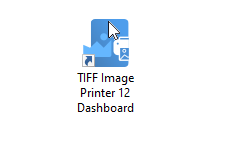
From the Dashboard tiles, click on Edit & Create Profiles to open the Profile Manager.
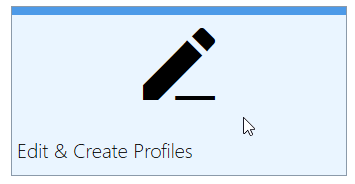
The Profile Manager is a separate application that opens in a new window. From here you can create brand new profiles, or start with a copy of an existing profile. We want to Add a new profile. Click the icon with the page and plus sign to create a new profile.

Once created, the first thing your profile needs is a name, and a description. We named ours “Demo“. You may want to use a more descriptive name. Next, we want to set this profile to create single page TIFF images.
The left hand side displays all categories of settings that are available. Clicking on a title will display the settings for that category on the right hand side. To create single page TIFF images we need to change the Save Options settings. The Profile Manager always starts with this category showing when first editing a profile.
Look for the Output Type and Color section, and change this to create TIFF Serialized (*.tif).
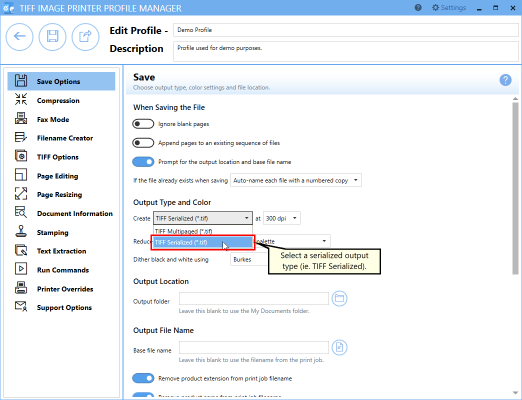
Setting the Output Location and Output File Name
Now that we are creating single page TIFF images, we also want to set a custom file name and folder in which to save our images. Using a custom name and location allows us to append to this series of TIFF images later when printing other documents.
Use the file icon to browse to the output folder you want, or type it in the field. When left blank, the printer will default to the last used folder. When there is no last used folder, files are saved in the My Documents.
We need a base file name to create our single page TIFF images, and to append to the series later. In the Output File File name section, set your desired base file name. Here we are using “Demo” as our base file name.
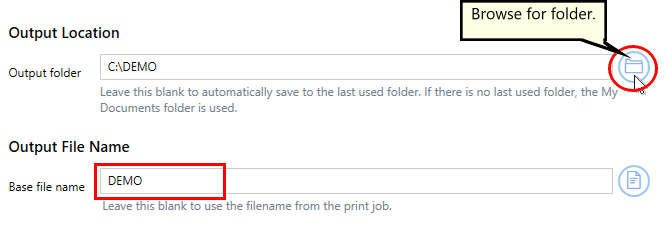
Setting the Printer Profile
Save the profile using the Save icon in the upper left, then return to the Profile Manager using the Back (left arrow) icon.
Your new profile is now available to choose from the Create File prompt when printing. You can also choose to use it as the default profile for the printer through Printer Management in the Dashboard. We’re going to set it as the default profile. Return to the Dashboard and this time select “Manage Printers“.
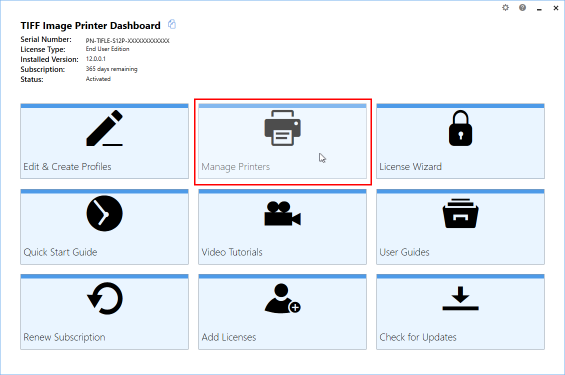
Printer Management lists all copies of your TIFF or Raster Image Printers. You start with just one, either TIFF Image Printer 12 or Raster Image Printer 12. From here you can add, copy and delete printers, and choose the profile the printer will use when creating images.
To use the new profile, click the drop box beside the printer name to select it from the list. We are choosing Demo, as that is the name of our profile created above. Choose your new profile from this list.
Click the Save icon beside the profiles drop box to save the changes to the printer. Then close both Printer Management and the Dashboard.
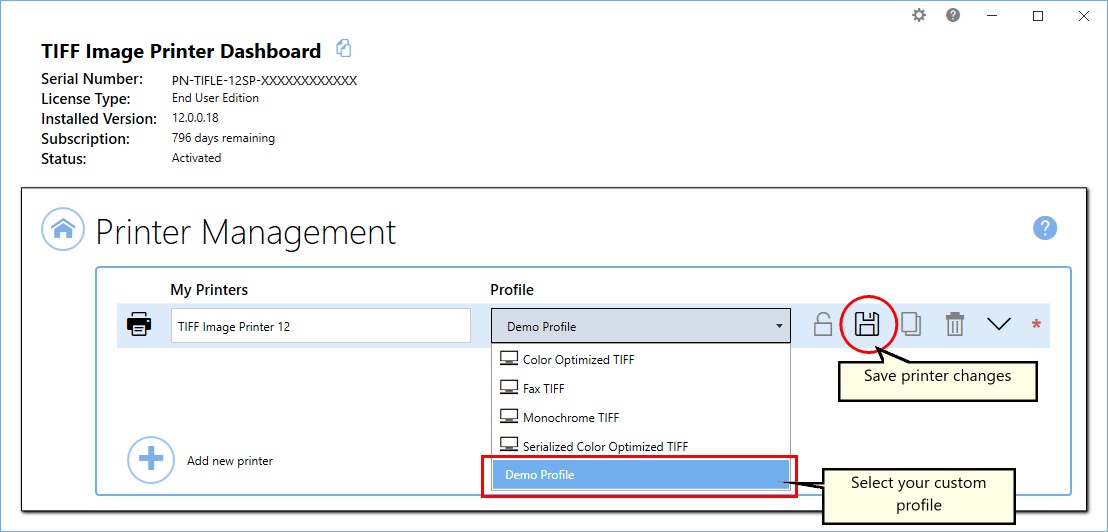
The printer will now create single page TIFF images in the location we want (C:\DEMO) and with a base file name of Demo. Printing a 3-page document would give us the following files in the C:\DEMO folder:
- DEMO_001.tif
- DEMO_002.tif
- DEMO_003.tif
Adding to an Existing Sequence of Files
If we want to keep adding single page TIFF images from other files to our series of TIFF images, we need to change our printer profile to turn on Append mode. When append mode is on, the printer looks for a matching base file name in the output folder. When creating multi-paged TIFF and a match is found, the pages are added to TIFF image file. For single page TIFF images, new images are created
Go back to the Dashboard, and open Edit & Create Profiles again to open the Profile Manager. Find your new profile and click the pencil icon to edit the profile.
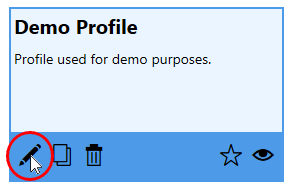
Back on the Save Options tab, turn on the option Append pages to an existing file.
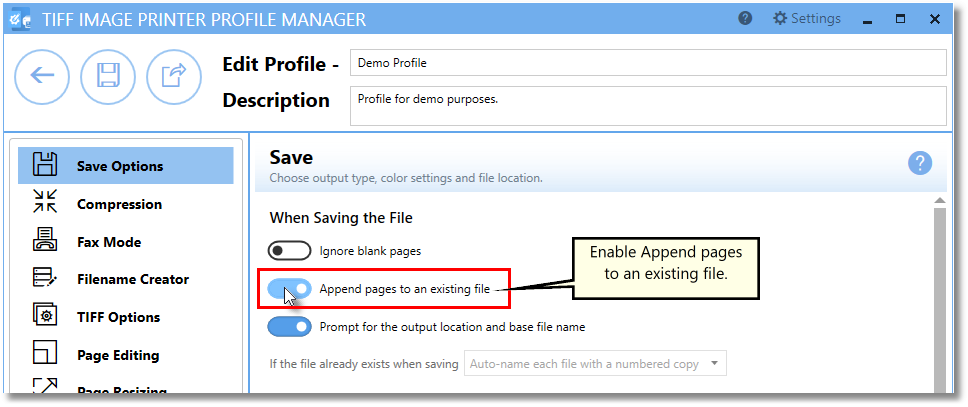
Save the changes to your profile using the Save icon in the upper left, then return to the Profile Manager using the Back (left arrow) icon. Close the Profile Manager.
Now each time you print, new single page TIFF images will be added to the series. Printing another 2-page document will add to our current series that stopped at DEMO_003.tif with the following single page TIFF images:
- DEMO_004.tif
- DEMO_005.tif



